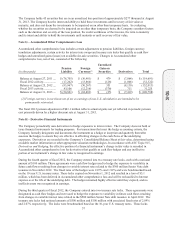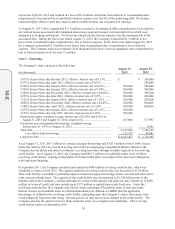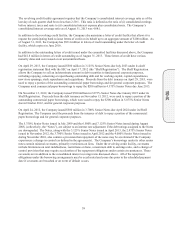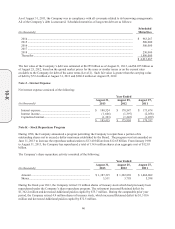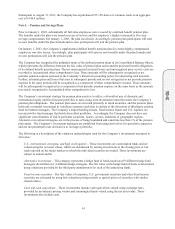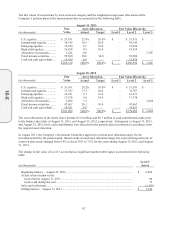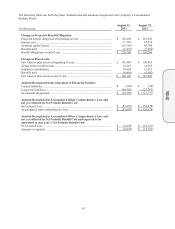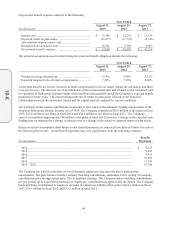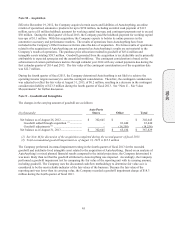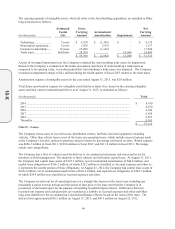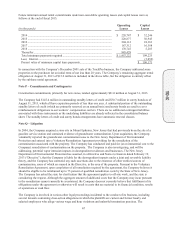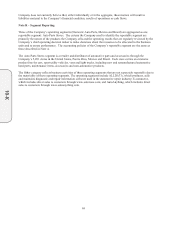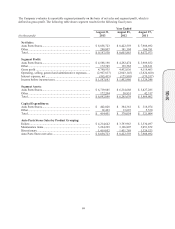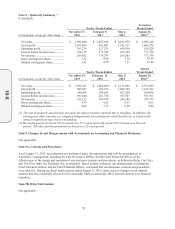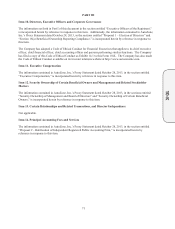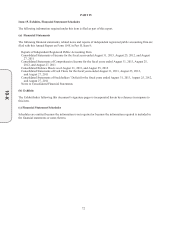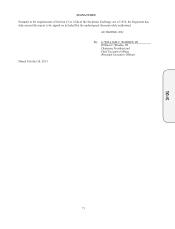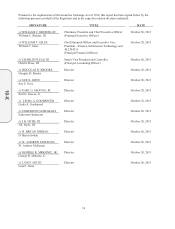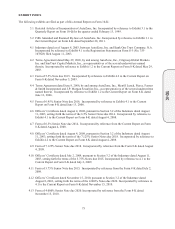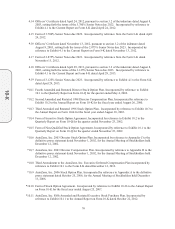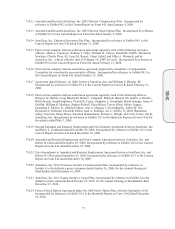AutoZone 2013 Annual Report Download - page 129
Download and view the complete annual report
Please find page 129 of the 2013 AutoZone annual report below. You can navigate through the pages in the report by either clicking on the pages listed below, or by using the keyword search tool below to find specific information within the annual report.
67
Future minimum annual rental commitments under non-cancelable operating leases and capital leases were as
follows at the end of fiscal 2013:
(in thousands)
Operating
Leases
Capital
Leases
2014 ................................................................................................................
.
$228,747
$ 32,246
2015 ................................................................................................................
.
220,877 30,943
2016 ................................................................................................................
.
204,112 24,363
2017 ................................................................................................................
.
187,312 16,388
2018 ................................................................................................................
.
170,745 5,283
Thereafte
r
........................................................................................................
.
945,429
–
Total minimum payments require
d
.................................................................
.
$ 1,957,222 109,223
Less: Interes
t
..................................................................................................
.
(3,052)
Present value of minimum capital lease payments..........................................
.
$ 106,171
In connection with the Company’s December 2001 sale of the TruckPro business, the Company subleased some
properties to the purchaser for an initial term of not less than 20 years. The Company’s remaining aggregate rental
obligation at August 31, 2013 of $15.6 million is included in the above table, but the obligation is entirely offset
by the sublease rental agreement.
Note P – Commitments and Contingencies
Construction commitments, primarily for new stores, totaled approximately $21.0 million at August 31, 2013.
The Company had $145.4 million in outstanding standby letters of credit and $30.7 million in surety bonds as of
August 31, 2013, which all have expiration periods of less than one year. A substantial portion of the outstanding
standby letters of credit (which are primarily renewed on an annual basis) and surety bonds are used to cover
reimbursement obligations to our workers’ compensation carriers. There are no additional contingent liabilities
associated with these instruments as the underlying liabilities are already reflected in the consolidated balance
sheet. The standby letters of credit and surety bonds arrangements have automatic renewal clauses.
Note Q – Litigation
In 2004, the Company acquired a store site in Mount Ephraim, New Jersey that had previously been the site of a
gasoline service station and contained evidence of groundwater contamination. Upon acquisition, the Company
voluntarily reported the groundwater contamination issue to the New Jersey Department of Environmental
Protection and entered into a Voluntary Remediation Agreement providing for the remediation of the
contamination associated with the property. The Company has conducted and paid for (at an immaterial cost to the
Company) remediation of contamination on the property. The Company is also investigating, and will be
addressing, potential vapor intrusion impacts in downgradient residences and businesses. The New Jersey
Department of Environmental Protection has asserted, in a Directive and Notice to Insurers dated February 19,
2013 (“Directive”), that the Company is liable for the downgradient impacts under a joint and severable liability
theory, and the Company has contested any such assertions due to the existence of other entities/sources of
contamination, some of which are named in the Directive, in the area of the property. Pursuant to the Voluntary
Remediation Agreement, upon completion of all remediation required by the agreement, the Company believes it
should be eligible to be reimbursed up to 75 percent of qualified remediation costs by the State of New Jersey.
The Company has asked the state for clarification that the agreement applies to off-site work, and the state is
considering the request. Although the aggregate amount of additional costs that the Company may incur pursuant
to the remediation cannot currently be ascertained, the Company does not currently believe that fulfillment of its
obligations under the agreement or otherwise will result in costs that are material to its financial condition, results
of operations or cash flow.
The Company is involved in various other legal proceedings incidental to the conduct of its business, including
several lawsuits containing class-action allegations in which the plaintiffs are current and former hourly and
salaried employees who allege various wage and hour violations and unlawful termination practices. The
10-K


